Solvent 646: composition and characteristics
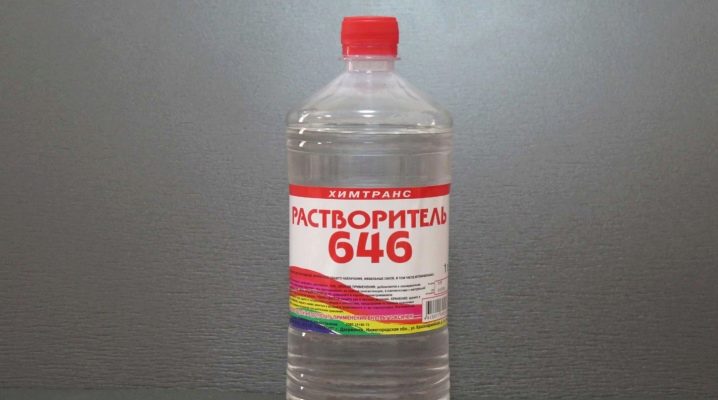
Today, solvents are presented on the construction market in a fairly wide range. The brands numbered 646 and 647 are in high demand among domestic consumers. At first glance, their compositions are identical. Nevertheless, there is a rather important difference between them, which determines the scope of use of these products.
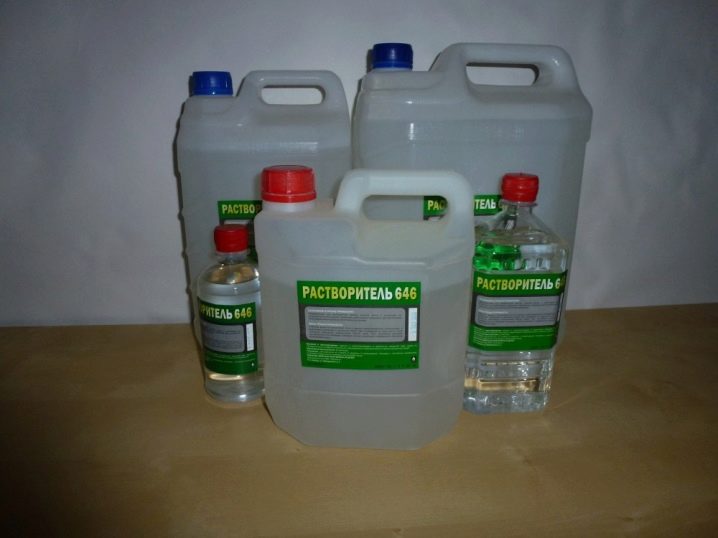
Peculiarities
Solvents include rapidly evaporating reagent mixtures consisting of several active components. They dissolve organic substances and form homogeneous compounds with them.
The main task of the solvent is to dilute paints and varnishes, giving them the required working consistency, therefore certain requirements are imposed on them:
- lack of any reaction with paints and varnishes;
- high evaporation rate;
- the composition must be non-hygroscopic;
- the interaction of the solvent and the coloring composition should take place without any effort.
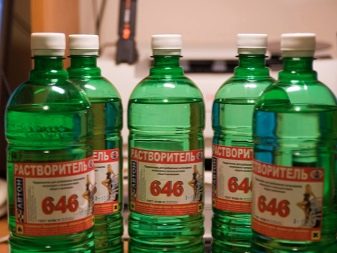

The solvent affects the paint only at the moment of its application, after which it evaporates without a trace. Each paint and varnish product corresponds to a certain type of solvent.
Thinner number 646 is a universal composition with a wide range of uses.
It is used for work with nitro-based varnishes and paints, and also interacts with epoxy and griftal primers.

The active components of P646 are:
- toluene - 50%;
- butanol - 15%;
- butyl acetate - 10%;
- ethyl alcohol - 10%;
- ethyl cellosolve - 8%;
- acetone - 7%.
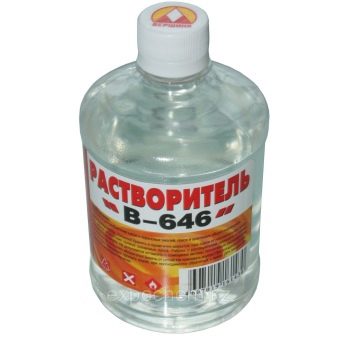
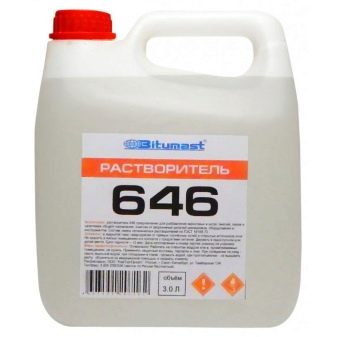
The main difference between 646 and 647 grades is their composition.
The latter does not contain acetone, it is considered not so active, due to which it is used on coatings that require the most careful and delicate handling, for example, when working with plastic. In all other cases, 646 should be preferred.
Today, solvent manufacturers are conducting research aimed at reducing the concentration of toluene and acetone in the reagent. This is due to the fact that these substances are often used in the manufacture of synthetic drugs.
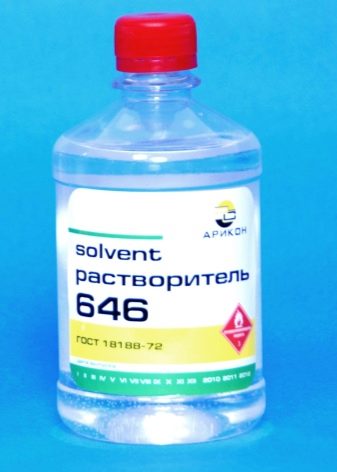
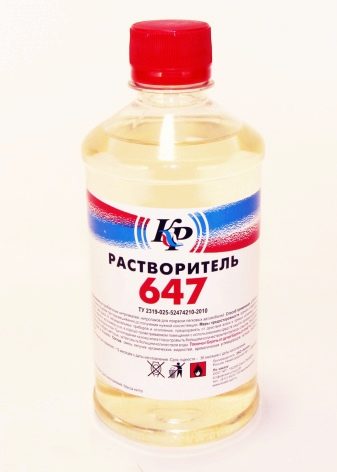
Pros and cons of P646
Among the undoubted advantages of such a solvent, it should be noted:
- versatility of use - it is effective on a wide variety of surfaces;
- exceptional dissolving activity - due to the multicomponent composition, the solvent can interact with almost any type of material;
- ease of use - no special skills are required to operate the product; everyone without construction education can understand the technical features of working with the composition;
- availability - the reagent can be bought at all hardware stores at an affordable price;
- when volatile substances dry, the surface acquires an additional shine and glossy appearance;
- does not leave streaks and greasy stains;
- evaporates quickly and leaves no odor;
- on contact with skin does not cause burns.
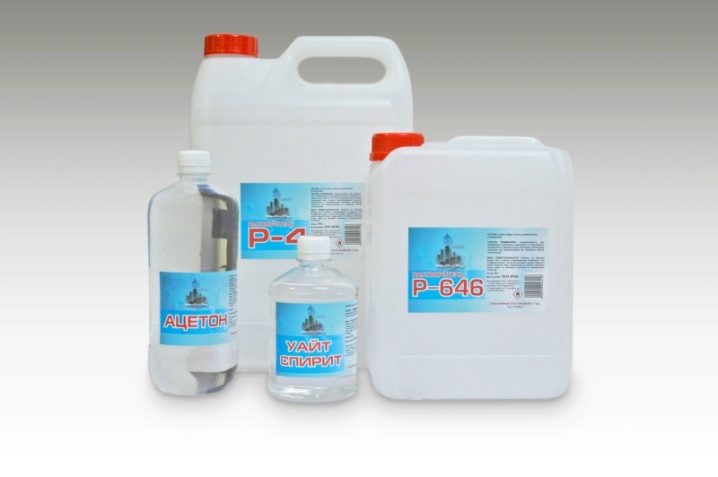
At the same time, the product also has a number of significant disadvantages:
- high toxicity of the composition;
- sharp unpleasant odor;
- high flammability.
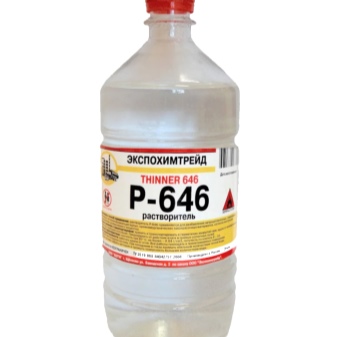

Thinner 646 is classified as hazard category III. Inhalation of its volatile vapor can cause pain, nausea, and complete or partial disorientation in space.
It has an adverse effect on the respiratory tract, digestive system, can lead to irritation of the mucous membranes of the eyes and the development of dermatitis.With prolonged work with a chemical, the likelihood of liver poisoning increases, changes in the biochemical composition of the blood and even damage to the bone marrow are noted, which leads to the most serious diseases. That is why the use of solvent number 646 requires special protective equipment. All work is recommended to be carried out in a well-ventilated area or outdoors in compliance with safety regulations.
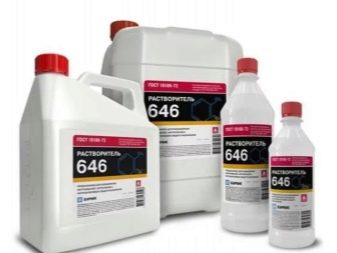
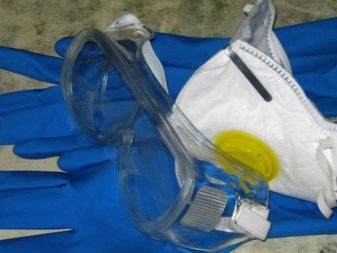
The composition requires special storage conditions to exclude the release of volatile vapors.
It is stored at temperatures from -40 to +40 degrees Celsius in an airtight container, excluding direct UV rays.
Do not store P646 outdoors, as well as in places where welding works. The ingress of sparks should be excluded, smoking is prohibited near the storage place - this is due to the high flammability of the composition. If a fire breaks out, it is extinguished with water, sand or foam.
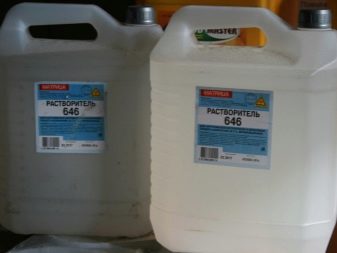
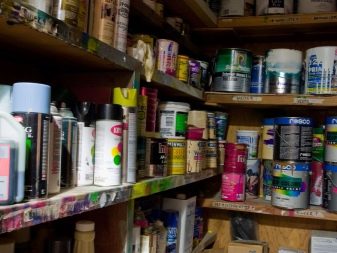
Specifications
P646 is sold in liquid form. The composition is transparent, rarely with a yellowish tinge.
Its formula determines the technical parameters:
- the density of the substance is 0.87 g / cm3, which is why it is ideally mixed with other solvents and paints and varnishes;
- the volatility coefficient ranges from 8 to 15;
- coagulation number - more than 35%;
- acid number - less than or equal to 0.06 mg KOH / g;
- the specific gravity of water does not exceed 2% (according to Fischer);
- boiling point - 59 degrees;
- spontaneous combustion temperature - 403 degrees;
- no freezing;
- no viscosity gain;
- hazard class - III.
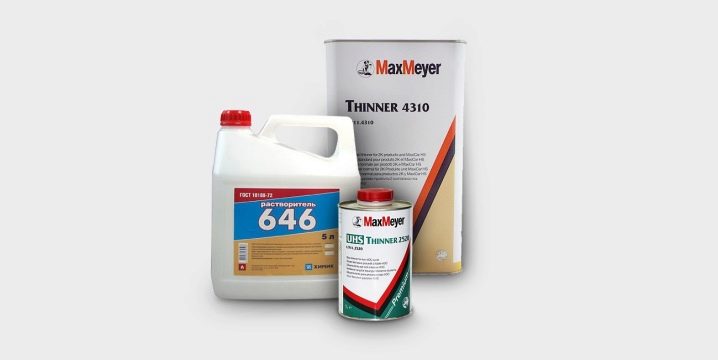
The technology of production and packaging of the solvent is based on the GOST 18188-172 standard.
When buying, pay attention to the structure of the liquid. The composition should be homogeneous, without stratification and the formation of a cloudy sediment. The mixture should not contain suspended particles.
It is sold in metal containers, as well as in containers made of glass or durable plastic with volumes of 1-10 liters. The composition is completely ready for use, does not require preliminary preparation. Retains its performance characteristics for 12 months. After the expiration date, the solvent is not recommended for use.
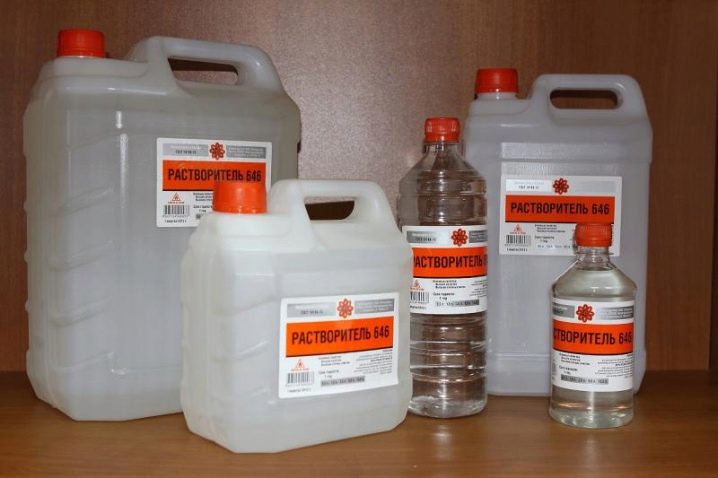
Scope of application
Thinner grade P646 is used when performing repair and finishing work. Its purpose is to effectively dilute paints, as well as varnishes and nitro enamels. The product works well for all types of paints and varnishes. Recent studies have shown that P646 works well with alkyd, epoxy and melamine products, various types of putties and primers.
It has proven itself well in the following types of repair and finishing works:
- to bring paints to the required viscosity;
- for thinning thickened and film-forming varnishes;
- in the manufacture of nitro-varnishes and nitro-enamels;
- the solvent is often added to the putty and primer in order to increase the elasticity and create the required viscosity, which makes it possible to technologically level the surfaces to ideal smoothness.
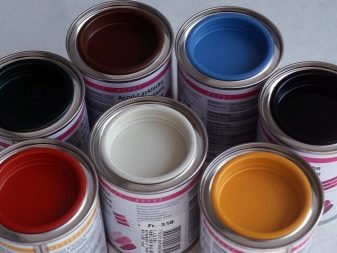
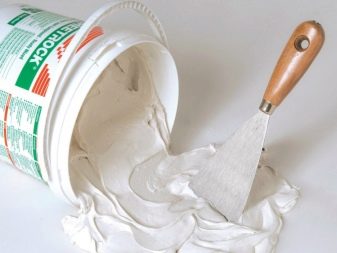
P646 is extremely effective, it can bring even the oldest and most dried paint to the desired consistency.
In addition, with its help, painting tools are cleaned from hardened paint, returning them to working condition.
Degreasing of surfaces is considered to be a separate direction of use of solvent grade 646. If the surface is not degreased before applying the primer, the coating will begin to peel off in place of the remaining grease stains, and the adhesion (adhesion of the finish to the base) will significantly deteriorate. All thinning compounds can perform a degreasing function. However, the use of P646 has its own specifics. This solvent is considered the most aggressive among its counterparts, its use requires special care. Acetone, which is an active component of the solvent, can damage the base, make its structure inhomogeneous, and lead to the appearance of irregularities.Acetone is especially aggressive to plastic, therefore it is not recommended to degrease plastic surfaces with it.
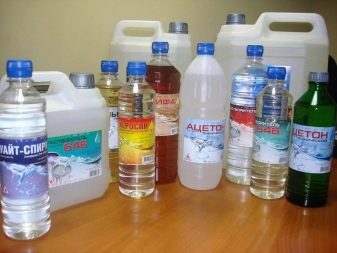
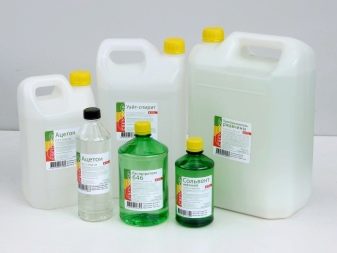
Any work with P646 is recommended to be carried out at a temperature of 5-30 degrees Celsius and a relative humidity of the room not higher than 85%.
The substance is toxic and volatile, therefore, it is optimal to use a respirator and gloves when working. It is recommended to wear special goggles to protect your eyes. If the substance comes into contact with the skin, the affected area should be treated with warm water and soap. If the solvent gets into the eye, you will have to immediately seek medical help at the nearest clinic.

The solvent is a highly flammable material.
In the room where the work is carried out, it is important to exclude any possibility of sparks hitting - do not smoke nearby, make a fire and carry out welding, otherwise the consequences can be the most dangerous.
Some "craftsmen" recommend pouring a solvent into gasoline to increase the octane number of the fuel, as well as to clean the nozzles and valves of the car's fuel system. Nevertheless, there are very few confirmed successful results of such actions, which means that there are no guarantees of its effectiveness.

R646 consumption
The solvent is added to the paint and varnish base in small portions with constant stirring until the desired viscosity is reached.
P646 is highly active, so handling this product requires care, otherwise the surface to be treated may be damaged.
Material consumption for degreasing per 1 sq. m is:
- for facade work, the required volume will be 0.147 liters;
- for surfaces made of metal or wood indoors - 0.12 l;
- for a layer of concrete - 0.138 l;
- for all types of surfaces in conditions of high humidity - 0.169 l.
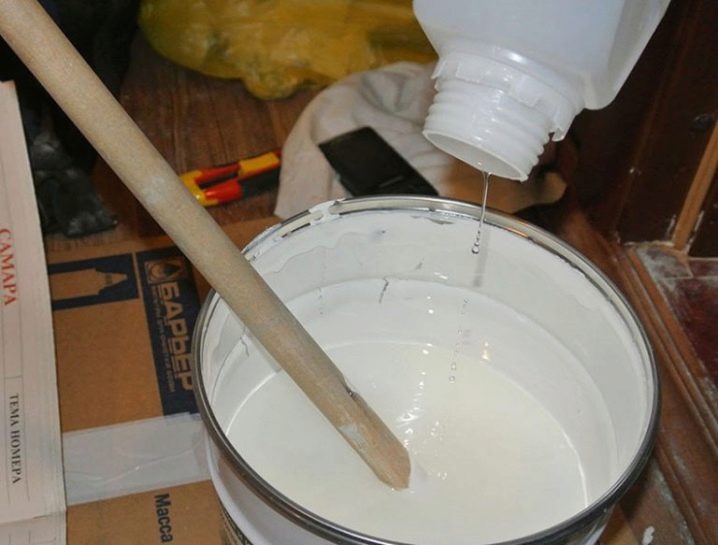
Solvent brand 646 is rightfully considered one of the most effective solvent compositions, therefore it is widely used in the repair of technological equipment.
- Together with varnishes XB-784. They are often used in production workshops to cover decarbonizing water tanks and liquid chemical cleaning, condensate tanks, water desalination tanks and purification pipelines. It is possible to use varnishes and enamels for this purpose only with solvent 646. Its standard consumption will be 0.086 l / m2.
- Together with NTs-11 enamel. which is suitable for processing metal surfaces operating in changeable weather conditions with a high degree of exposure to moisture, including sea water, as well as oil products. P646 is used to dissolve this paint at the rate of 0.528 kg per sq. m. coverage. For non-metallic coatings operating under similar conditions, NTs 1200 enamel is used, it is diluted based on the standard of 0.147 l / m2.
- For internal repair work, you should give preference enamels NTs-25... The proportion of its dilution is 0.120 liters per square meter of surface.
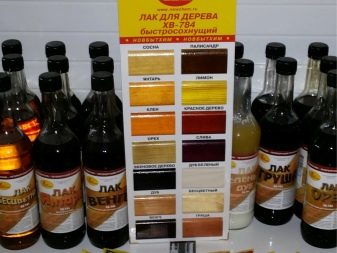
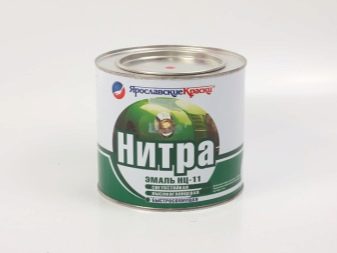
To protect porous layers of concrete and brick from the adverse effects of alkalis and acids, a putty is used. At the same time, it can only show its consumer properties more efficiently when diluted with a high-quality solvent - this will require 1.2 liters of P646 per square meter. If the putty is used to protect the insides of lighting tanks, containers for acid-base compounds and the insides of sodium cation filters, the solvent consumption will be lower - 0.138 l / m2.
Enamel EP-5116used to treat the coating of pipelines and oil reservoirs, diluted with a solvent at a ratio of 0.169 liters per square meter.
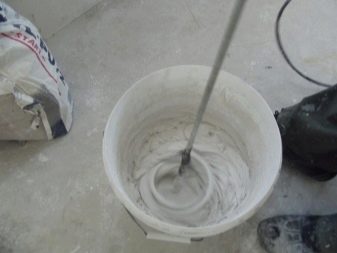
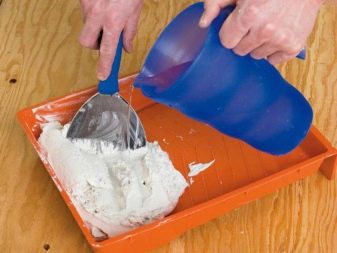
Manufacturers
Quality products can only be purchased from a reliable manufacturer. Products that meet all the requirements and technological standards are produced by several manufacturers.
- Dmitrievsky chemical plant - a company with a century of history, specializing in the production of chemicals for industry.
- Upper Volga paint and varnish factory - a well-known domestic supplier of varnishes, enamels, paints, solvents and primers on the Russian market and in the CIS countries.
- "Polycom" - one of the leaders in the segment of the production of industrial and household chemicals.
- "Yaskhim" - the creator of the highest quality petrochemical solvents.
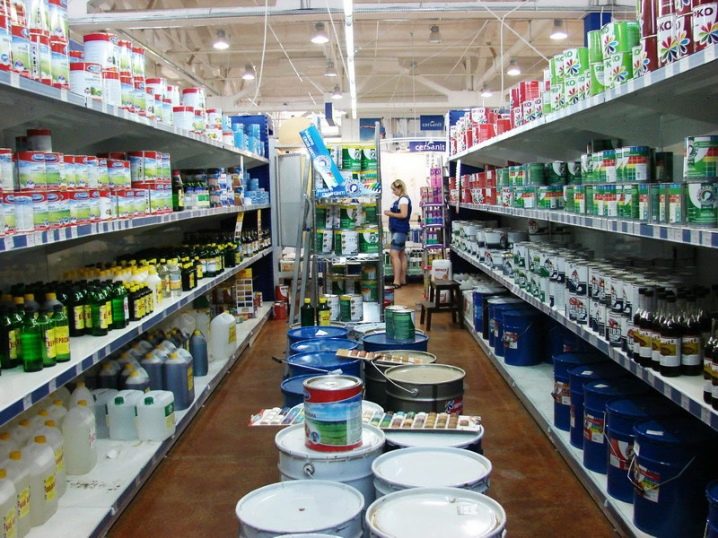
All of these manufacturers have increased requirements for product quality and operate in accordance with GOST standards.
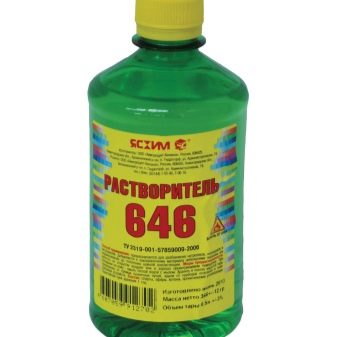

In conclusion, a few facts about the solvent that should be borne in mind when starting to work with this combustible composition:
- a mixture of volatile solvent vapors and air is considered quite explosive;
- the accumulation of concentration in the air, hazardous to life and health, if the container with P646 is kept open, occurs rather quickly;
- solvent vapors are heavier than air - they sink down and can be located directly above the floor or ground;
- ignition is possible even at a distance, when there is no direct contact between fire and chemical;
- when interacting with vinegar and hydroperite, explosives are formed;
- a dangerous reaction of P646 with chloroform and bromoform is noted, which creates a fire hazardous situation.
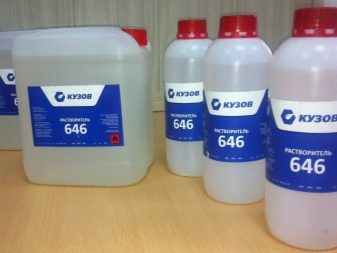
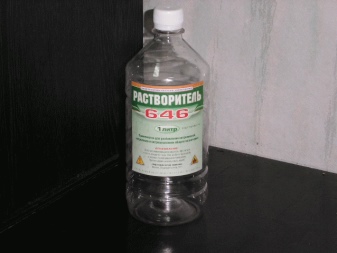
For more information on the characteristics of solvent 646, see the following video.













The comment was sent successfully.